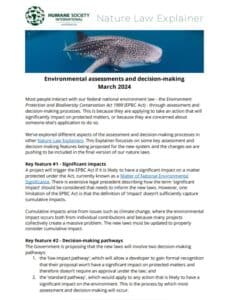One of the most important global meetings on wildlife trade has just wrapped up in Uzbekistan. It’s capital city Samarkand was where governments convened for the 20th Conference of the Parties (CoP20) to the Convention on International Trade in Endangered Species of Wild Fauna and Flora (CITES) to decide how international trade should be managed for some of the world’s most threatened...
March 2024
Most people interact with our federal national environment law – the Environment Protection and Biodiversity Conservation Act 1999 (EPBC Act) – through assessment and decision-making processes. This is because they are applying to take an action that will significantly impact on protected matters, or because they are concerned about someone else’s application to do so.
We’ve explored different aspects of the assessment and decision-making processes in other Nature Law Explainers. This Explainer focusses on some key assessment and decision-making features being proposed for the new system and the changes we are pushing to be included in the final version of our nature laws.
Key feature #1 – Significant impacts
A project will trigger the EPBC Act if it is likely to have a significant impact on a matter protected under the Act, currently known as a Matter of National Environmental Significance. There is extensive legal precedent describing how the term ‘significant impact’ should be considered that needs to inform the new laws. However, one limitation of the EPBC Act is that the definition of ‘impact’ doesn’t sufficiently capture cumulative impacts.
Cumulative impacts arise from issues such as climate change, where the environmental impact occurs both from individual contributions and because many projects collectively create a massive problem. The new laws must be updated to properly consider cumulative impact.
Key feature #2 – Decision-making pathways
The Government is proposing that the new laws will involve two decision-making pathways:
- the ‘low impact pathway’, which will allow a developer to gain formal recognition that their proposal won’t have a significant impact on protected matters and therefore doesn’t require an approval under the law; and
- the ‘standard pathway’, which would apply to any action that is likely to have a significant impact on the environment. This is the process by which most assessment and decision-making will occur.
The new laws will also set out the process for assessment and the matters that must be considered in making a decision on whether to approve or reject a proposal. Current drafting of the new laws makes these processes far too subjective and discretionary. Instead, the proposed new pathways must be based on clear and unambiguous unacceptable impacts and the mandatory application of strong, objective National Environmental Standards.
Key feature #3 – Environment Information Australia
It is proposed that a new body – Environmental Information Australia (EIA) – will be responsible for ensuring that decision-makers and the public have access to authoritative, high-quality information and data and that decision-making is based on best available information. EIA will also be responsible for holding data, and where possible, mapping key information such as critical habitat. This will give the EIA a foundational role for good decision-making and it is vital that it is appropriately resourced to fulfil that function.
It is also proposed that the EIA will be responsible for delivering State of the Environment reports every two years and environmental economic accounts annually. They will develop an environmental baseline against which to measure progress towards achieving a nature positive Australia.
Another role we’d like to see for the EIA is to track progress against recovery and threat abatement strategies. This centralising of environmental data will make an important contribution to better understanding whether the reformed laws are effectively reversing the extinction crisis.
Key feature #4 – Accreditation
The EPBC Act currently allows for assessment and decision-making processes to be ‘accredited’. That means that instead of the Minister for the Environment being responsible for assessment or decision-making under national environment laws, the accredited person or body is. Accreditation for decision-making is problematic because it removes the Minister with primary responsibility for environmental protection from decision-making in ‘accredited’ situations. Humane Society International Australia has long opposed this type of accreditation and is disappointed to see that it is proposed to carry this system over to the new laws. The new system must ensure that all decision-making on whether a project should be approved decisions are undertaken by an independent Environment Protection Australia. This will be important in ensuring an effective nationally coordinated system of assessment and decision making that delivers good outcomes for our wildlife and their habitats.
Key feature #5 – Nature positive laws
It is also proposed that application of the new laws will have to be ‘nature positive’. The Government’s Nature Positive Plan describes this as “circumstances where nature – species and ecosystems – is being repaired and is regenerating rather than being in decline.” This is an important high level goal and we look forward to seeing how it will be embedded in the new laws.
Download a PDF version of this blog, so you can print and share with your Member of Parliament.

Learn more about what we need to achieve stronger laws for Australian nature. Read our other Nature Law Explainer blogs:
- What are National Environmental Standards and why do we need them?
- The importance of an “EPA”
- Critical habitat needs protection
- Managing wildlife trade
- Objects and Duties
- Strengthening Conservation Planning
- Climate change
- Community Rights in Decision Making
- Protecting Marine and Migratory Species
- Regional Planning
- What Triggers the EPBC act?
- What are biodiversity offsets? (Part 1)
- What are biodiversity offsets? (Part 2)
- What ‘triggers’ the EPBC Act?
- Strong nature laws shouldn’t be undermined by exemptions


